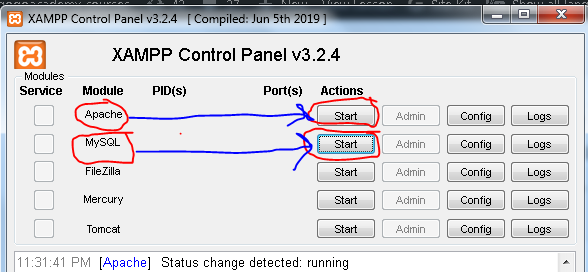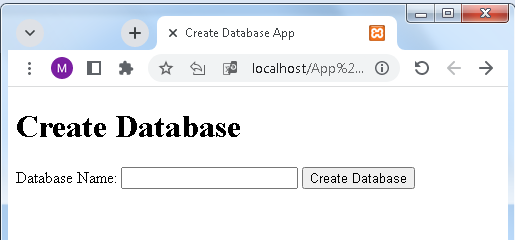How to Use PHP to create Database in XAMPP MySQL ?
Learn How to Create a MySQL Database with PHP and XAMPP: Step-by-Step Guide
Introduction:
Explore the process of creating a MySQL database using PHP and XAMPP with this comprehensive step-by-step guide. Whether you’re a beginner or looking to enhance your web development skills, this lesson covers the essentials of setting up a database for your projects.
Creating a MySQL database using PHP and XAMPP involves a few steps.XAMPP is a popular cross-platform web server solution that includes Apache, MySQL, PHP, and Perl.
Here’s a basic guide on how you can use PHP to create a MySQL database using XAMPP:
Step1:Install XAMPP:
Download and install XAMPP from the official website: https://www.apachefriends.org/index.html.
Follow the installation instructions for your operating system.
Step2 :Start the XAMPP Server:
After installation, start the XAMPP control panel.
Start the Apache server and MySQL.

step3:Create a PHP File:
Open your preferred text editor and create a new PHP file, e.g., create_database.php.
step4 :Write PHP Code to Connect and Create Database
Write PHP Code to Connect and Create Database:
Add the following PHP code to your create_database.php file:
<?php
$servername = "localhost"; // Change this if your MySQL server is running on a different host
$username = "root"; // Default username for XAMPP MySQL is "root"
$password = ""; // Default password is blank for XAMPP MySQL
// Create connection
$conn = new mysqli($servername, $username, $password);
// Check connection
if ($conn->connect_error) {
die("Connection failed: " . $conn->connect_error);
}
// Create a new database
$databaseName = "your_database_name";
$sql = "CREATE DATABASE IF NOT EXISTS $databaseName";
if ($conn->query($sql) === TRUE) {
echo "Database created successfully";
} else {
echo "Error creating database: " . $conn->error;
}
// Close the connection
$conn->close();
?>
Replace “your_database_name” with the desired name for your database sa youlike .
Step5:Run the PHP Script:
- Save the create_database.php file in the htdocs directory inside the XAMPP installation folder.
- For example, C:\xampp\htdocs\create_database.php
- Open your web browser and navigate to http://localhost/create_database.php.
This will execute the PHP script and create the specified database.

step 6:Verify Database Creation:
- Open the MySQL Database Server using phpMyAdmin or another MySQL client to verify that the database has been created.
- Go to:localhost/phpmyadmin to see the database is created as the following :

- That’s it! You have successfully used PHP to create a MySQL database with XAMPP.
An application
How to create a new MySQL database by submitting a form?
- Let’s create a simple web application that allows users to create a new MySQL database by submitting a form.
- We’ll use HTML for the form and PHP to process the form data and create the database.
Follow the step-by-step explanation below:
Step 1: Create HTML Form
Create a new file named index.html and add the following HTML code:
<!DOCTYPE html> <html lang="en"> <head> <meta charset="UTF-8"> <meta name="viewport" content="width=device-width, initial-scale=1.0"> <title>Create Database App</title> </head> <body> <h1>Create Database</h1> <form action="create_database.php" method="post"> <label for="dbname">Database Name:</label> <input type="text" id="dbname" name="dbname" required> <button type="submit">Create Database</button> </form> </body> </html>
This HTML code creates a simple form with a text input for the database name and a submit button.

Step 2: Create PHP Script to Process Form
Create a new file named create_database.php and add the following PHP code:
<?php
if ($_SERVER["REQUEST_METHOD"] == "POST") {
// Database connection parameters
$servername = "localhost"; // Change this if your MySQL server is running on a different host
$username = "root"; // Default username for XAMPP MySQL is "root"
$password = ""; // Default password is blank for XAMPP MySQL
// Create connection
$conn = new mysqli($servername, $username, $password);
// Check connection
if ($conn->connect_error) {
die("Connection failed: " . $conn->connect_error);
}
// Process form data
$databaseName = $_POST["dbname"];
$sql = "CREATE DATABASE IF NOT EXISTS $databaseName";
if ($conn->query($sql) === TRUE) {
echo "Database created successfully";
} else {
echo "Error creating database: " . $conn->error;
}
// Close the connection
$conn->close();
}
?>
This PHP code checks if the form has been submitted (POST method) and then processes the form data to create the specified database.
Step 3: Save and Run the Application
- Save both files (index.html and create_database.php) in the htdocs directory inside your XAMPP installation folder.
- Start the XAMPP server and open your web browser.
- Navigate to: http://localhost/index.html.
Fill in the database name in the form and click the “Create Database” button. - The PHP script will run, and you should see a message indicating whether the database creation was successful.
Quiz about creating a MySQL database using PHP and XAMPP:
- A quiz with 15 questions related to the lesson on creating a MySQL database using PHP and XAMPP.
- Each question will be followed by an explanation.
Quiz Questions:
1. What is XAMPP?
a. A programming language
b. A web server solution
c. An operating system
d. A database management system
Explanation:
XAMPP is a cross-platform web server solution that includes Apache, MySQL, PHP, and Perl.
2. Which of the following is included in XAMPP?
a. Apache
b. MySQL
c. PHP
d. All of the above
Explanation:
XAMPP includes Apache, MySQL, PHP, and Perl, making it a comprehensive web development stack.
3. What is the default username for XAMPP MySQL?
a. admin
b. user
c. root
d. mysql_user
Explanation:
The default username for XAMPP MySQL is “root.”
4. What does the PHP code $conn->connect_error check for?
a. Database existence
b. Successful connection
c. Database creation error
d. Connection error
Explanation:
$conn->connect_error checks for a connection error when attempting to connect to the MySQL server.
5. In PHP, how do you create a new database using MySQLi?
a. CREATE DATABASE new_database;
b. INSERT INTO new_database;
c. CREATE TABLE new_database;
d. CREATE DATABASE IF NOT EXISTS new_database;
Explanation:
To create a new database in PHP using MySQLi, you use the CREATE DATABASE IF NOT EXISTS new_database; statement.
6. Where should you save a PHP file to be executed by the XAMPP server?
a. C:\Program Files\XAMPP\
b. C:\xampp\htdocs\
c. C:\xampp\php\
d. C:\xampp\bin\
Explanation:
You should save a PHP file to the htdocs directory inside the XAMPP installation folder, typically C:\xampp\htdocs\.
7. What does the HTML attribute action=”create_database.php” specify?
a. The method of the form
b. The PHP script to process the form data
c. The type of input field
d. The target URL for form submission
Explanation:
action=”create_database.php” specifies the PHP script that will process the form data when the form is submitted.
8. How do you access form data submitted via the POST method in PHP?
a. $_POST[“data”]
b. $_GET[“data”]
c. $_REQUEST[“data”]
d. $_SERVER[“data”]
Explanation:
To access form data submitted via the POST method in PHP, you use $_POST[“data”].
9. What does the PHP code $conn->query($sql) === TRUE check for?
a. Successful SQL query execution
b. SQL syntax error
c. Database creation error
d. Connection error
Explanation:
$conn->query($sql) === TRUE checks if the SQL query was executed successfully.
10. What is the purpose of the HTML tag <button type=”submit”> in a form?
a. Adds a submit button to the form
b. Defines a clickable button
c. Initiates the form submission
d. Creates a reset button
Explanation:
<button type=”submit”> initiates the form submission when clicked.
11. Which PHP function is used to close a MySQLi connection?
a. mysqli_close()
b. close_connection()
c. disconnect_mysql()
d. mysql_close()
Explanation:
The correct function to close a MySQLi connection is mysqli_close().
12. What is the purpose of the HTML attribute required in an input field?
a. Specifies the input type
b. Makes the input field read-only
c. Requires the user to enter a value
d. Sets a default value for the input
Explanation:
The required attribute in an input field makes it mandatory for the user to enter a value before submitting the form.
13. What is the default password for XAMPP MySQL?
a. admin
b. user
c. root
d. mysql_password
Explanation:
The default password for XAMPP MySQL is often blank, meaning no password is set by default.
14. What is the purpose of the HTML tag <label> in a form?
a. Defines a form control
b. Adds a clickable button
c. Provides a title for an input field
d. Initiates the form submission
Explanation:
<label> provides a title or description for an input field in a form, improving accessibility and user experience.
15. What does the MySQL query CREATE DATABASE IF NOT EXISTS do?
a. Creates a new database
b. Deletes an existing database
c. Checks if a database exists before creating
d. Modifies the structure of a database
Explanation:
CREATE DATABASE IF NOT EXISTS checks if a database exists and creates it if it doesn’t, preventing an error if the database already exists.
